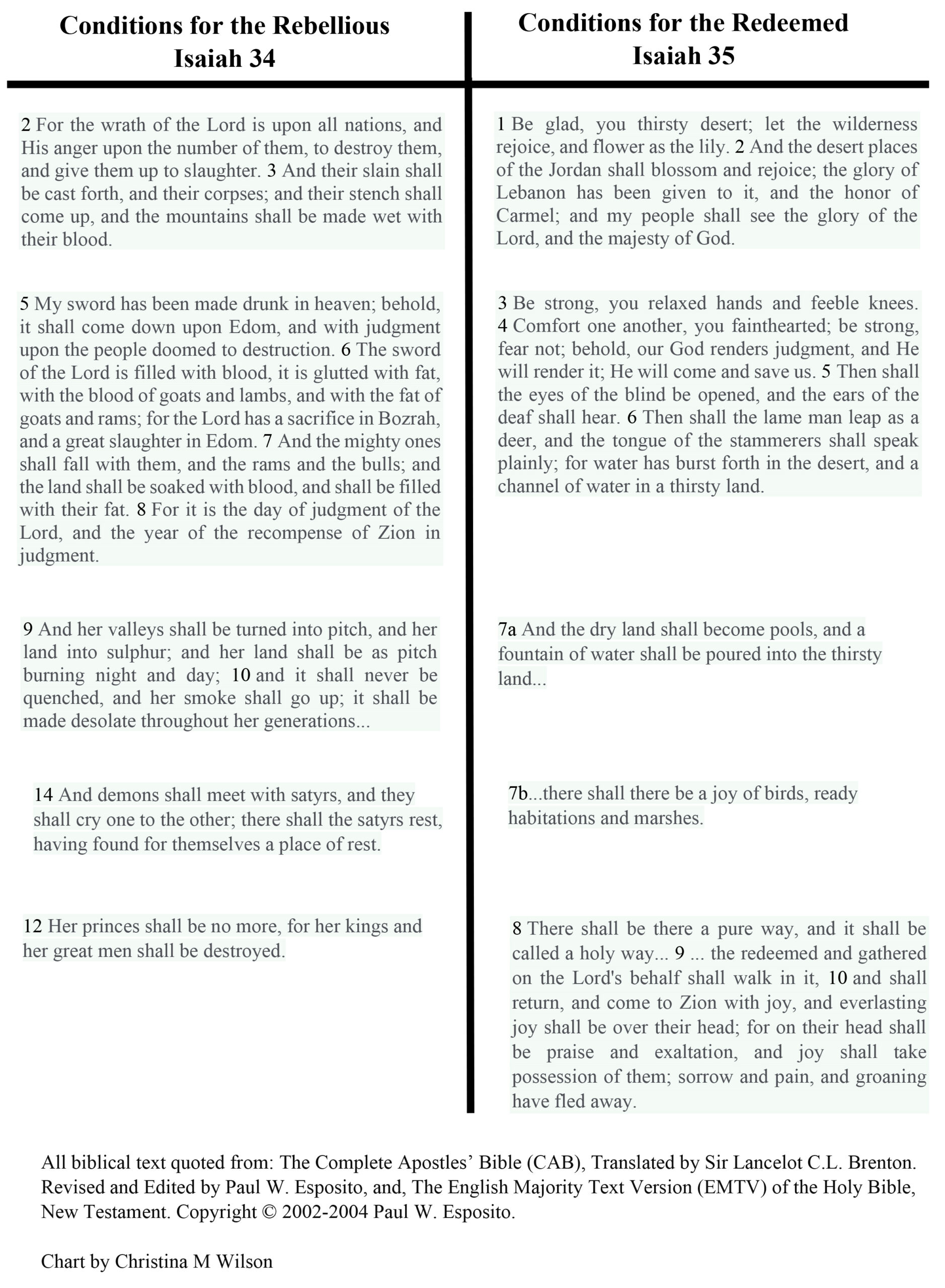Isaiah 34-35 Septuagint Modernized NETS

Overview
Readers should consider Chapters 34 and 35 of Isaiah together. These two chapters together present the outcome of all human history, the end of time, in a manner similar to Psalm 1 (LINK1 and LINK2).
Chapter 34 gives the final outcome for the “damned”–those who persistently and willfully resist God and the goodness of his nature.
Chapter 35 gives the final outcome for those in the Kingdom of Messiah. Messiah is God’s Son who saves and redeems the poor in heart and spirit. These are people who look to him for their personal well-being and improvement of their condition. These are they who seek to obey their Savior/King. They believe in the goodness and holiness of God and give him their full allegiance.
Summary of Chapter 34
Most commentators conclude that in Chapter 34 God pronounces his final judgment against all nations (see verses 1 and 2, where the text contains the phrase “all nations.”) Further, in Isaiah 34 (Link to Various Commentaries) Edom represents all who oppose God and his people, who are represented by Zion (Isaiah 34:8).
That is, readers should not think that the chapter makes specific reference to Edom alone. The Jewish Study Bible points out that in “later Jewish history… the Edomites… converted to Judaism en masse during the late 2nd C. BCE, and were among the most zealous Jews during the conflict with Rome in the 1st C. CE,” (2). This is similar to other places in Scripture in which Babylon becomes a symbol for all that is unholy. See, for example, Isaiah 13 through 14 and Revelation 18:2-24.
One point of interest is that the text does not specify specific actions and attitudes in this section of final judgment. The Old Testament as a whole and Isaiah in particular catalog those elsewhere (See, for example, Isaiah 14:5-6). This chapter devotes itself to descriptions of God’s eternal punishment of the unrepentant wicked.
Summary of Chapter 35
Everyone agrees that Isaiah 35 speaks of Messiah. Chapter 35 is one of the most glorious chapters in Isaiah. It merits rereading (even out loud) two or three times, simply to capture the beauty of its words and images.
New Testament authors group Isaiah 35:5-6 with Isaiah 26:19; 42:18; and 61:1 (1). This occurred when Jesus provided John the Baptist a summary list of his ministry when he was in prison (Matthew 11:5 and Luke 7:22). Clearly, the time frame referred to is the first advent of Messiah.
Isaiah 35:5 Then shall the eyes of the blind be opened, and the ears of the deaf shall hear. 6 Then shall the lame man leap as a deer, and the tongue of the stammerers shall speak plainly; for water has burst forth in the desert, and a channel of water in a thirsty land. (CAB, LXE)
Luke 7:22 And he answered them, “Go and tell John what you have seen and heard: the blind receive their sight, the lame walk, lepers are cleansed, and the deaf hear, the dead are raised up, the poor have good news preached to them. (ESV)
Contrasts with Chapter 34
Chapter 35 contrasts with the previous chapter in many aspects. Where there is destruction in Chapter 34, there is a renewal of life in Chapter 35. Where there is blood of all kinds flowing in 34, there is healing of all kinds in 35. Where demons and satyrs gather in 34, birds sing joyfully in 35. Finally, where there is God’s wrath in Chapter 34, there is the glory of the Lord and the majesty of God in Chapter 35.

Time Frame of Chapter 35
But what of the time frame of Chapter 35? When will Messiah appear and under what circumstances? At what point in Israel’s history will these events occur? Quite bluntly, does this chapter prophesy the first coming of Christ and the literal-spiritual realities of life in his kingdom? Or, is this chapter millennial/dispensational?
I. Jesus Applies Isaiah 35:5-6 to His First Advent
As stated above, Jesus sent his disciples to the imprisoned John the Baptist in Luke 7:22 and Matthew 15:30. He told them to tell John the highlights of his ministry. These highlights combined prophesies from various portions of Isaiah (Isaiah 26:19; 35:5-6; 42:18; 61:1) (1). But clearly, the application made by Jesus in Luke and Matthew was to his then present, that is, his first advent.
II. The Chapter Gives No Hint of More Than One Advent
Isaiah himself in chapter 35 gives no hint of more than one advent. Verse 2 states in part, “My people shall see the glory of the Lord and the majesty of our God.” One of the strongest messages of the gospel writers is the glory of Christ, which they and countless multitudes of people witnessed in his incarnation.
III. The Dispersed (Septuagint) Shall Walk in the “Holy Way”
Verse 8 differs in the Septuagint from the Masoretic. While the Masoretic speaks of “fools,” the Septuagint speaks of the “dispersed.”
8 There shall be there a pure way, and it shall be called a holy way; and there shall not pass by there any unclean person, neither shall there be there an unclean way; but the dispersed shall walk on it, and they shall not go astray. (CAB, LXE)
In the so-called Millennium, will there be a dispersion? Yet, both before and after Rome destroyed Jerusalem (70 CE), shortly after Christ’s incarnation, the new believers dispersed from Jerusalem and became missionaries around the known world.
IV. All Was Fulfilled by Christ’s Incarnation
Everything in Isaiah 35 was and is fulfilled in Christ’s current kingdom. This chapter prophesies the joy of the Lord, which Christians sing about as a present reality every Sunday.
9 … but the redeemed and gathered on the Lord’s behalf shall walk in it, 10 and shall return, and come to Zion with joy, and everlasting joy shall be over their head; for on their head shall be praise and exaltation, and joy shall take possession of them; sorrow and pain, and groaning have fled away. (CAB, LXE)
V. Jesus Described His Kingdom as Eternal Life
Chapter 34 is an end times chapter. It speaks the finality of the last judgment. If, then, Chapter 35 deals with Messiah’s present kingdom, how do these two time frames match?
Simply, Christ’s kingdom is eternal, now. When Christ sent his Holy Spirit, he sent eternity into believers’ hearts now.
John 5:24 Truly, truly, I say to you, whoever hears my word and believes him who sent me has eternal life. He does not come into judgment, but has passed from death to life.
John 6:47 Truly, truly, I say to you, whoever believes has eternal life.
John 6:54 Whoever feeds on my flesh and drinks my blood has eternal life, and I will raise him up on the last day.
The final state of Christians has already begun in their hearts and spirits. Jesus Christ will raise believers up on the last day. There will be no judgment for those who believe in Messiah King. The beginning state of a believer’s heart is also the down payment of the final state (Ephesians 1:13-14). Eternal life in Christ begins now and will continue long past the final judgment of those who rebel against God’s goodness.
Conclusion
In conclusion, nowhere in all of Isaiah is the word “millennial” used. God kept Isaiah fairly busy describing Messiah’s incarnation, his identity as God’s Son, and his perfect, glorious, loving nature. It would seem odd in this most amazing chapter, for Isaiah to jump over the incarnation in favor of a bodily appearance at some unspecified time more than 2700 years afterward. I for one am perfectly content to enjoy the fullness of the Lord’s kingdom in the present moment, here and now. And when the final judgment of Chapter 34 occurs, the end of time, believers of Chapter 35 will be ushered into the Lord’s eternal presence.
__________
1 Archer, Gleason L. and Gregory Chirichigno. Old Testament Quotations in the New Testament. Eugene, Oregon: Wipf & Stock, 1983, pages 102-103 and 110.
2 The Jewish Study Bible, Second Edition. Adele Berlin and Marc Zvi Brettler, Editors, Jewish Publication Society TANAKH Translation. Oxford University Press, New York, New York, 2014, page 833.
